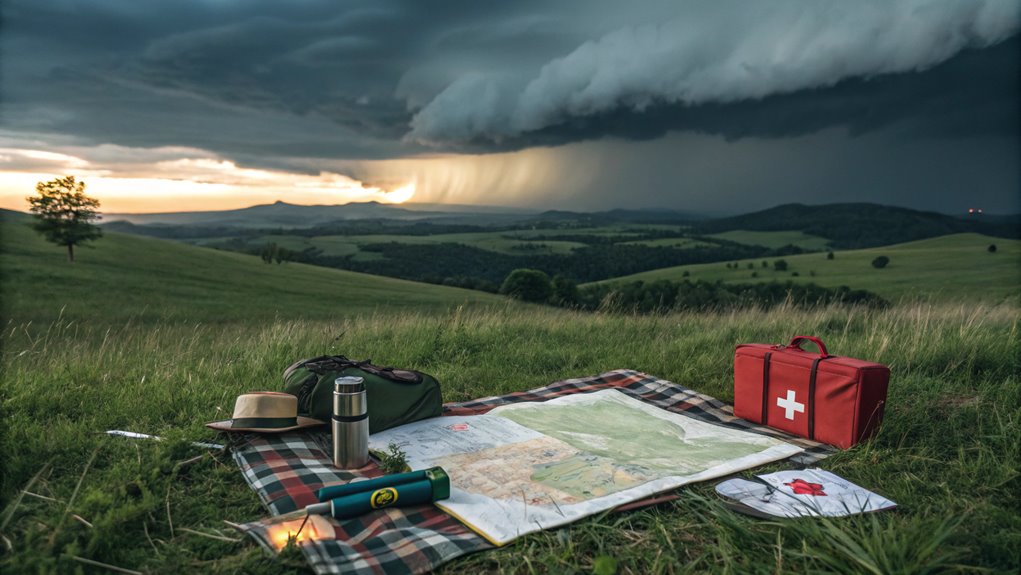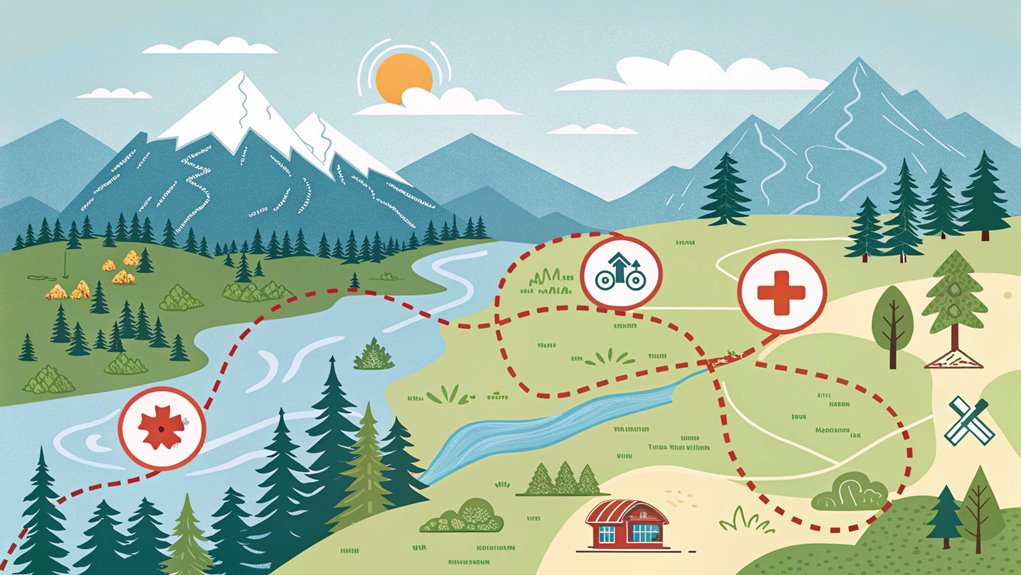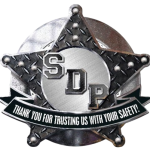When you're traveling, staying safe during natural disasters is super important. First, make an emergency plan that includes local contacts, hospitals, and police stations—know who to call! Always keep an eye on local weather alerts through apps or news stations, so you aren't caught off-guard. Don't forget to pack an emergency kit with first aid supplies, non-perishable snacks, and plenty of water. It's also smart to have an evacuation map handy, marking out routes and nearby shelters. Being prepared can keep you and your loved ones safe, and there's a lot more helpful info to discover!
Emergency Preparedness Peace of Mind

When you're traveling, knowing how to stay safe during a natural disaster is super important, and having a solid emergency plan can give you real peace of mind. Make sure you've got access to local emergency contacts, travel insurance coverage, and a list of emergency kit essentials, so you're ready for anything. It might feel overwhelming, but being prepared means you can focus on enjoying your trip instead of worrying about what could go wrong. Personal safety devices, like the Personal Panic Alarm, provide an effective deterrent against potential attackers, making them a crucial addition to your emergency preparedness kit. For added security, consider carrying a portable personal alarm like the 2n1 Personal Burglar Alarm, which can be a reliable companion in emergencies.
Access to Local Emergency Contacts
How can you guarantee your safety during a natural disaster while traveling? One essential step is to access local emergency contacts. Before you set off, research local resources like hospitals, fire departments, and police stations. Jot down their numbers, or save them on your phone for quick access. You don't want to be scrambling for help when time's running out!
Establish communication strategies with your travel companions, so everyone knows how to reach each other if you get separated. Whether it's using walkie-talkies, text messages, or social media, staying connected can make all the difference.
Travel Insurance Coverage
While knowing local emergency contacts helps you respond effectively during a natural disaster, having travel insurance can provide additional peace of mind. It's super important to compare policies before you travel, because not all insurance plans cover the same things. Some might help with canceled trips, while others may support emergency medical costs. Understanding the claim process is also essential, so you know what to do if you need to file a claim.
Here's a quick comparison to help you out:
| Coverage Type | Importance |
|---|---|
| Trip Cancellation | Protects your travel costs |
| Emergency Medical | Covers unexpected medical fees |
| Evacuation | Helps with emergency exits |
With the right insurance, you're one step closer to safe travels!
Emergency Kit Essentials
An emergency kit can be a lifesaver during natural disasters, especially when you're traveling. You never know when you might need it, so packing some essentials is super important.
Here's what you should include:
- First aid supplies (band-aids, antiseptic wipes, and pain relievers)
- Non-perishable food supplies (granola bars, dried fruit, or canned food)
- Water (at least a gallon per person per day)
- Flashlight and batteries (to see in case of power outages)
Having these items on hand can provide peace of mind and keep you safe in tricky situations.
Remember, being prepared is key, and it can make all the difference when disaster strikes.
Stay safe out there!
Local Weather Alerts Availability
Where can you find reliable local weather alerts while traveling? Staying updated is super important, especially during natural disasters! You can use weather alert systems like apps or websites that provide timely notifications. Before your trip, download a trusted weather app on your phone—many of them let you set alerts for your specific location. Don't forget to check local news stations or radio broadcasts, as they often share real-time updates. Also, consider following social media accounts of local emergency management agencies; they're great for getting immediate information. Personal security alarms emit up to 130dB sound to deter attackers and attract attention, providing an additional layer of safety in emergencies.
Evacuation Route Planning

Planning your evacuation routes ahead of time can make all the difference in an emergency. You don't want to find yourself in a panic, wondering where to go when a natural disaster strikes.
First, grab an evacuation map of the area you're visiting. Look for the designated escape routes, and don't forget to check for route alternatives in case of roadblocks or heavy traffic. Familiarize yourself with these routes, and consider practicing how to get to safety.
It's also a good idea to note nearby shelters, hospitals, or safe zones. By being prepared and knowing where to go, you'll feel more in control during a stressful situation, which can help keep you and your loved ones safe.
Travel Safety App Features
Knowing your evacuation routes is only part of staying safe while traveling during a natural disaster.
You'll want to have a travel safety app on your phone that offers real-time notifications about weather updates, emergency alerts, and local conditions. This feature can give you vital information when you need it most, helping you make quick decisions.
Look for an app with a user-friendly interface—this means you can easily navigate it, even in stressful situations. It should have maps, emergency contacts, and safety tips all in one place.
With the right app, you'll feel more prepared and secure, knowing you can stay informed and connected during a natural disaster.
Don't underestimate the power of technology in keeping you safe!
Answers to Common Questions
What Should I Pack for Emergencies While Traveling?
When packing for emergencies while traveling, include an emergency kit with essentials like a flashlight, first aid supplies, and water. Don't forget travel essentials like snacks, a map, and your important documents for added safety.
How Can I Find Local Emergency Contacts?
How would you handle an emergency if you didn't know who to call? Check local resources or download emergency apps for quick access to contacts, ensuring you're prepared no matter where you are.
Is Travel Insurance Necessary for Natural Disasters?
Travel insurance is essential, especially for natural disasters. It protects you from unexpected expenses, like trip cancellations or medical emergencies. You don't want to face financial burdens when nature throws a curveball during your travels.
How Do I Choose Safe Accommodations During Disasters?
When choosing accommodations, you'll want to prioritize disaster preparedness and accommodation safety. Look for places with emergency plans, secure structures, and easy evacuation routes. Your safety's paramount, so trust your instincts and research thoroughly.
What First Aid Supplies Should I Carry While Traveling?
When traveling, you should always carry first aid supplies like band-aids, antiseptic wipes, and pain relievers. Don't forget emergency essentials like a whistle and flashlight; they could be vital in unexpected situations. Stay prepared!
Bottom Line
When you're on the road, keeping safe during natural disasters should be your top priority. Think of it like having a trusty umbrella when dark clouds gather; you wouldn't want to get soaked! So, stay alert with local weather alerts, plan your escape routes, and make sure your travel safety app is ready to go. By being prepared, you're not just protecting yourself; you're ensuring a smoother journey, come rain or shine. Stay safe out there!




